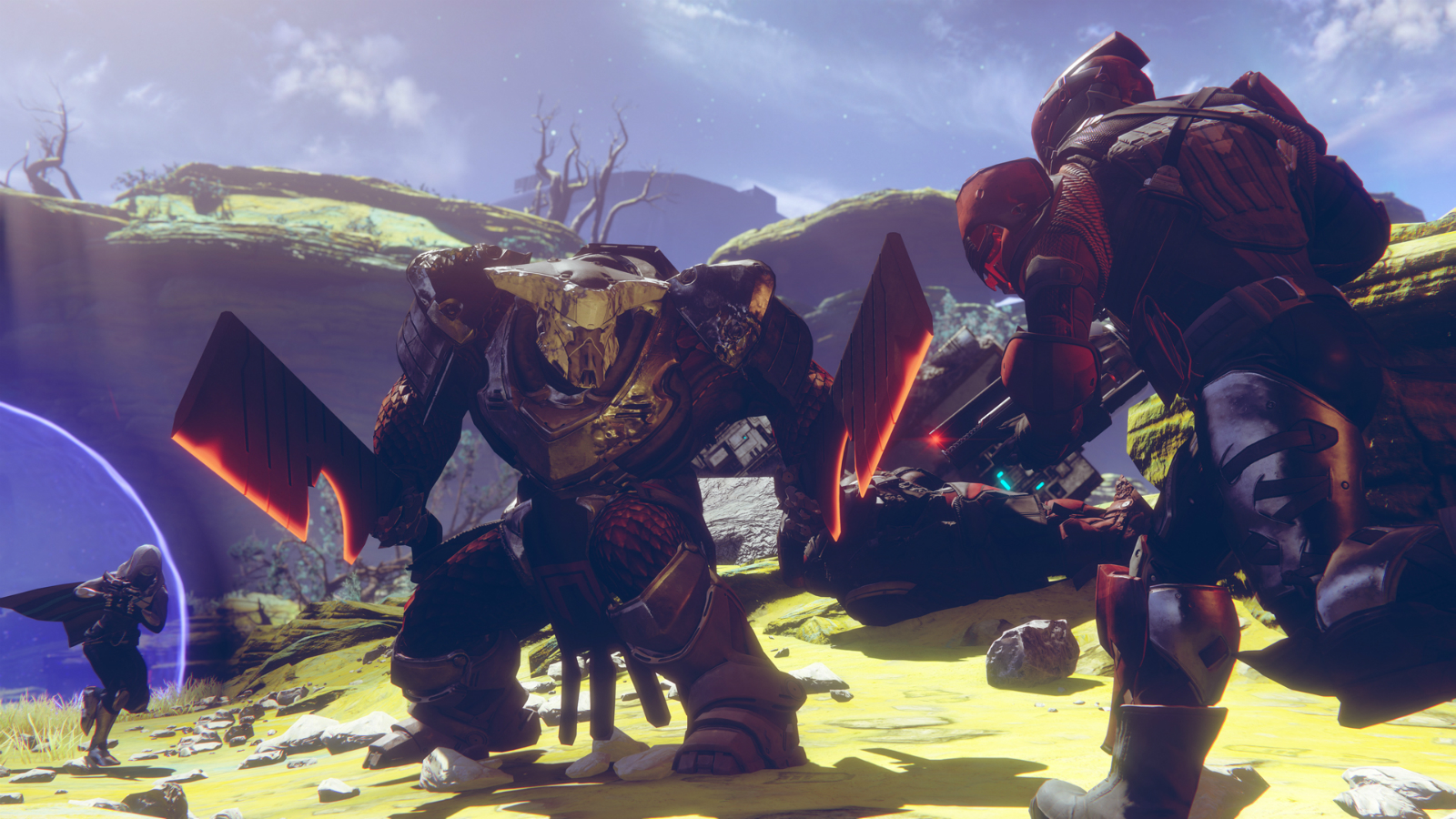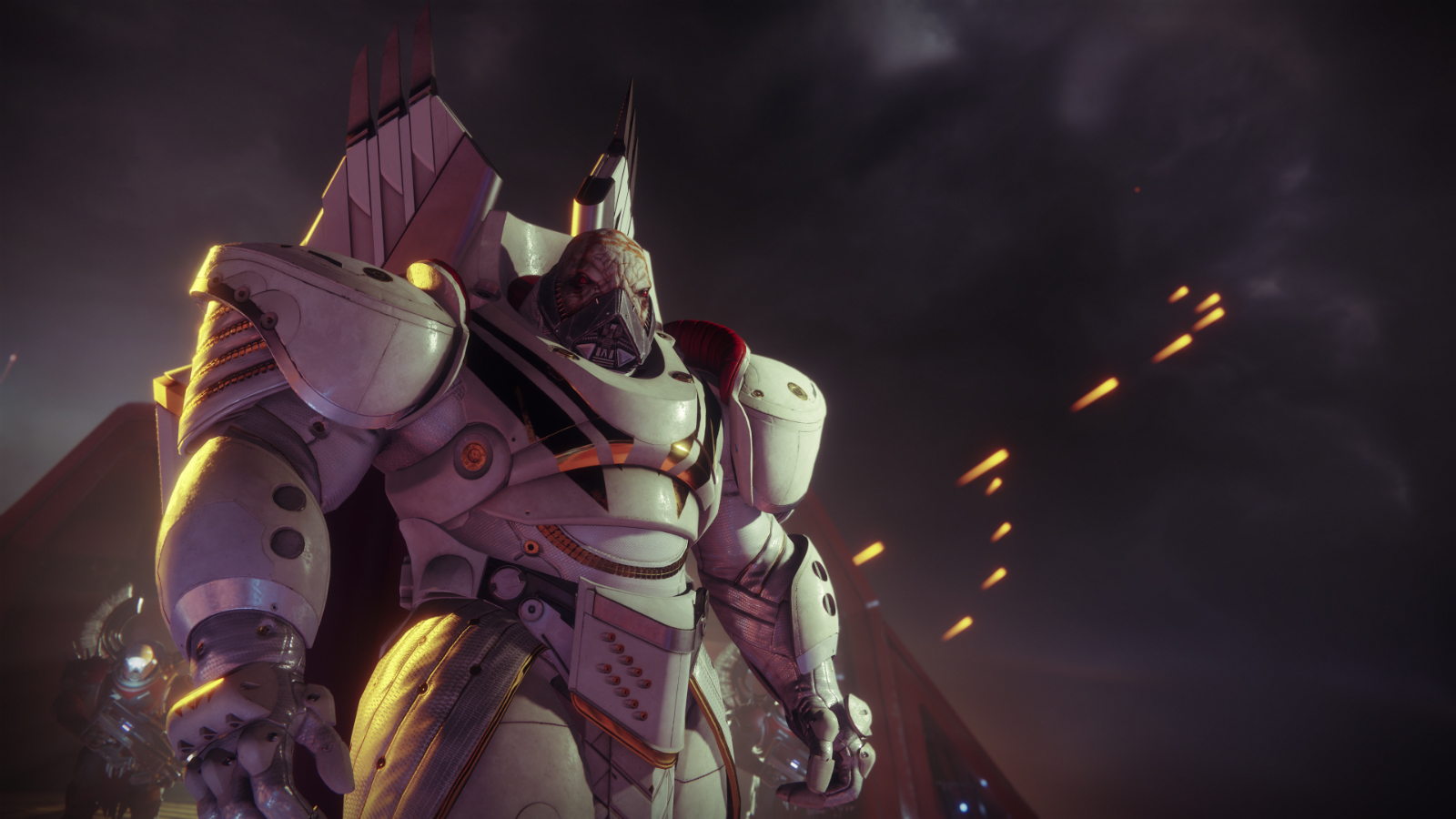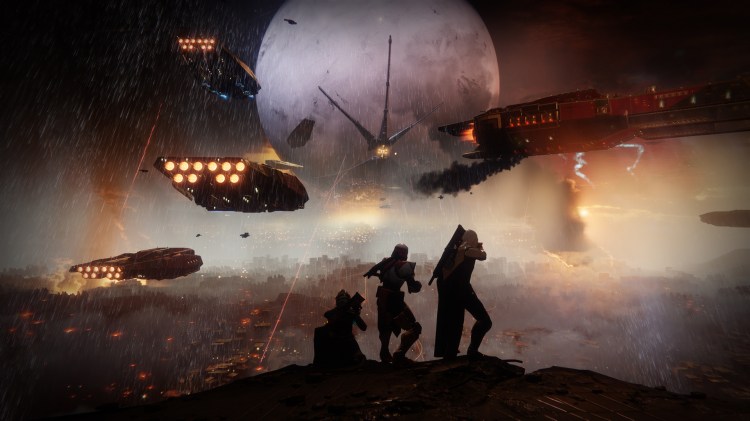Armor in the first Destiny had attribute rolls that determined whether the piece of armor made your Guardian faster, tougher, or recover from damage more quickly. Destiny 2 players can mod armor to control the benefits it lends to your character which, again, makes sticking with favorite gear more tenable rather than having to get rid of something you like just because it doesn’t do precisely what you need it do to.
Improved enemy design
The undead-like Hive and robot Vex enemies we encountered so far seemed mostly identical to their counterparts in the original Destiny. The Fallen and Cabal enemy factions, on the other hand, feature some new variety.
Shanks, robotic gun turrets used by the Fallen, would float in the air and maybe change elevation slightly in the first Destiny. Shanks in Destiny 2 sink and dodge, attack in swarms, and can attack from very high elevations. Some types of Fallen will use their four arms and two legs to scuttle like crabs up walls or across the ground at the player, which is unnerving.
Cabal Psions used to be standard infantry units that attacked from close or medium range. They are snipers in Destiny 2. Cabal Incendiors have flamethrowers with area of effect fire attacks that can herd you into a corner. Cabal Centurions now have jet packs and can make your cover meaningless. Cabal Gladiators are powerful melee-based enemies you do not want to get close to. Changes to the Hive are mostly aesthetic and the Vex seem mostly the same as in the original Destiny, however.
June 5th: The AI Audit in NYC
Join us next week in NYC to engage with top executive leaders, delving into strategies for auditing AI models to ensure fairness, optimal performance, and ethical compliance across diverse organizations. Secure your attendance for this exclusive invite-only event.

Above: Gladiators add deadly melee units to the Cabal military’s arsenal.
Vehicles have a higher profile
Bungie’s Halo series made great use of vehicles like Warthog jeeps and Scorpion tanks. The way the first Destiny almost ignored vehicles was one of that game’s biggest letdowns.
Destiny 2 on the European Dead Zone map provides many opportunities to use vehicles like Fallen Pikes and Cabal Interceptors. We could expect to run into players piloting either vehicle on a regular basis. Vehicles don’t play as large a part on the other three planets Io, Nessus, and Titan, but hopefully the prevalence of vehicles in the European Dead Zone speaks to future intent for Destiny 2’s expansions.
No more returning to orbit
In the original Destiny you had to take an intermediary step before traveling from place to place, cutting from whatever planet or social space you were in to a shot of your spacecraft in orbit. Then you could select and enter your next activity. Constantly having to return to orbit in the first Destiny wasted time you could have spent actually playing the game.
Destiny 2 eliminates the need to return to orbit. You can travel from one location to another without the intermediary “return to orbit” sequence getting in the way. It speeds things up appreciably.
What you won’t like
Crucible limits teams to four players
The average Crucible team size in the original Destiny maxed out at 6. Four players are always make up a Crucible team in Destiny 2. This has the effect of making Crucible play faster and more decisive because when two teams run into each other there are fewer people to kill in order to wipe out the other team.
The first Destiny’s Crucible had more of a deliberate, Halo-like pace. Destiny 2 feels like it’s moving closer to faster first-person-shooters like Call of Duty and Overwatch. It’s a change that not everyone will meet kingly.
The Crucible is running more smoothly than ever and this improved performance may have everything to do with dropping the maximum team size and thus the number of players attempting to simultaneously connect to a Crucible lobby. It also feels easier to try and sync up with 3 random players rather than with 5. While the benefits of dropping maximum Crucible team size to 4 seem clear, players of the original Destiny may still have a problem with this change.

Above: Crucible teams cap at four players, not six, in Destiny 2.
No transportation early in the game
In the original Destiny you received your Sparrow hoverbike early on. In Destiny 2 you have to traverse huge, open maps on foot while you run through long stretches of map with no enemies or anything else of interest. These long stretches are spaces that feel clearly intended to allow players to have some fun with Sparrows and instead feel like artificial bloating of the map space, forcing players to remain on foot, which slowed down travel and made the maps feel larger than they actually were. Even with the ability to fast travel between different points on the open-world maps there was still plenty of running around to be done and it was frustrating.
Destiny 2 players are finally granted their personal Sparrow vehicle after the story ends, so no worries about running across huge stretches of landscape devoid of any content ad infinitum. The total Destiny 2 package is so good that quibbling about lack of Sparrow access for six to eight hours almost feels trite. The lack of a Sparrow in the early game is just as annoying while leveling a second or third character as it was when we leveled our first character, however.
One benefit of not having a Sparrow in the early game is more opportunities to find and scan lore objects. We would guess that we’ll be finding new lore objects in the world for a while to come. For veterans of the original Destiny, or anyone that doesn’t care about finding secrets on the maps, be prepared to be very frustrated at the lack of a Sparrow early on.
The story plays it very safe
The story in Destiny 2 reminded us of the story in Star Wars: The Force Awakens. Disney realized it couldn’t afford to screw up its first Star Wars movie after taking over the franchise, so The Force Awakens played it safe. Perhaps Bungie similarly realized that after the fracas over the original Destiny’s weak story the studio could not afford to make the same mistake with Destiny 2, and that’s why the plot about Cabal invaders didn’t feel like it was taking any risks.
There is also a storyline about Guardians losing the Light, and thus the ability to return to life once “killed.” The idea that Guardians are all persons returned from the dead was not mentioned often in the original Destiny, even though this is a very important aspect of the lore. Including this facet of the universe outside of a Grimoire and into the game itself was a good idea.
As safe as the overall plot may feel and as uninteresting as the villain Ghaul may be for some players, the story in Destiny 2 ends with a conclusion so satisfying that it might for some players make up for whatever other shortcomings the story may present. It did for us. We can only hope that the ending to Destiny 2 remains unspoiled for a while. The post-credits sequence in Destiny 2 is to Destiny fans what the post-credits scene of a Marvel movie is to Marvel Cinematic Universe junkies.

Above: Ghaul, leader of the Cabal army, is jealous of the Guardians and their power.
What we can’t know (yet)
The guided games question
Destiny is part first-person shooter and part massively multiplayer online game. There is a quintessential conflict created by this hybrid design. MMO players are used to organizing on websites and message boards for endgame play. FPS players on console don’t have to do anything like this to enjoy multiplayer gaming for the long term.
To try and address the issue, Destiny 2 includes a feature called “Guided Games” meant to help players find Clans to tackle content with. The Guided Games feature entered a beta phase the week after Destiny 2 was launched. Any Destiny 2 player may volunteer as a Guide, but only players with a special ticket have been invited to try Guided Games as a Seeker.
Guided Games so far have been frustrating. We’ve had luck finding groups but no one in those groups has had a microphone activated. The Weekly Nightfall we tried Guided Games with had a time limit, and grouping up with Guides who didn’t know when we’d fallen too far behind the clock such that it was time to quit out of the activity was irritating. It made us question why these players were Guides in the first place.
It’s too early to judge the Guided Games system definitively as it is in a beta state, but right now our impression is that Guided Games will likely solve none of Destiny’s social issues, and Destiny 2 players will still need to go to outside sources like DestinyLFG and The100 to find other players to tackle Destiny 2’s most challenging content with.
Whether the Raid is any good
The original Destiny launched with a six-player Raid called the Vault of Glass. It was a mind-bending experience unlike anything Destiny players had previously experienced in the game. The following three Raids added via game expansions were of varying quality.
Destiny 2 is shipping with a Raid named Leviathan. We’ve only been able to step into the first few stages of the new Raid. What we’ve seen so far hasn’t been groundbreaking and it doesn’t feel so far like the new Raid would sway our overall opinion of Destiny 2 in either direction.
Conclusion
Destiny 2 is everything you could ask for in a sequel. The systems of the original Destiny have been tweaked and tuned. The graphics quality is superlative. Destiny 2 feels less like a grind, is easier to get into, and is a superior project to the original Destiny in almost every way.
For casual players Destiny 2 is a pure win. It is very easy to log on to Destiny 2 for 60 to 90 minutes, run a few activities, and feel like you’ve accomplished something meaningful while being appropriately rewarded.
For hardcore players it’s more complicated. The vast majority of Destiny 2’s content can begin to feel irrelevant once you hit Power level 265 out of a maximum 300 because almost all the gear you earn through open-world activities, Strikes, Crucible matches, Challenges, etc. drops at too low a Power level to allow your character to advance. Unless your character advances you cannot attempt the Weekly Nightfall Strike or the Leviathan Raid. Thus describes the mid-game grind in any massively multiplayer online game.
You can achieve two Milestones (read: quests) per week that will grant powerful gear. It might only take a single day to achieve them, and you ought to be able to complete them solo. Every other opportunity to earn gear worth your time requires a Clan, or just a group of people to play with. This is where Destiny 2 continues to suffer the same social issues as Destiny 1, because Destiny 2 doesn’t adequately help you find a group of people to play with either.
Bungie’s idea of blending MMO games and first-person shooters is ambitious, and Destiny 2 finally makes it clear that this hybrid design mostly works. Once Bungie figures out how to jump the social hurdle Destiny 2 will shine even brighter.
If you were a fan of the original Destiny and you haven’t jumped on board yet with Destiny 2 get yourself in the game. You’re already behind on the Power grind!
If you avoided the original Destiny because of its launch issues have no such fears with Destiny 2. And if you’re just curious about Destiny 2 and want to play casually you can find plenty of quick, satisfying things to do while enjoying some of the best art, sound design, music scoring, and shooting mechanics in the video game industry.
Score: 95/100
Destiny 2 is out now for PlayStation 4 and Xbox One. GamesBeat received PS4 and Xbox One codes from Activision for the purposes of this review. This score is now final.


